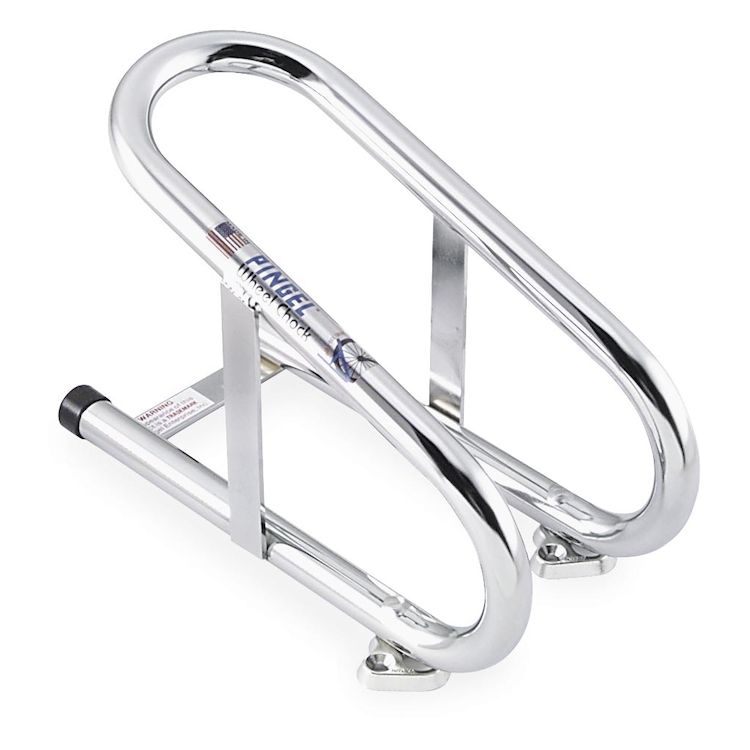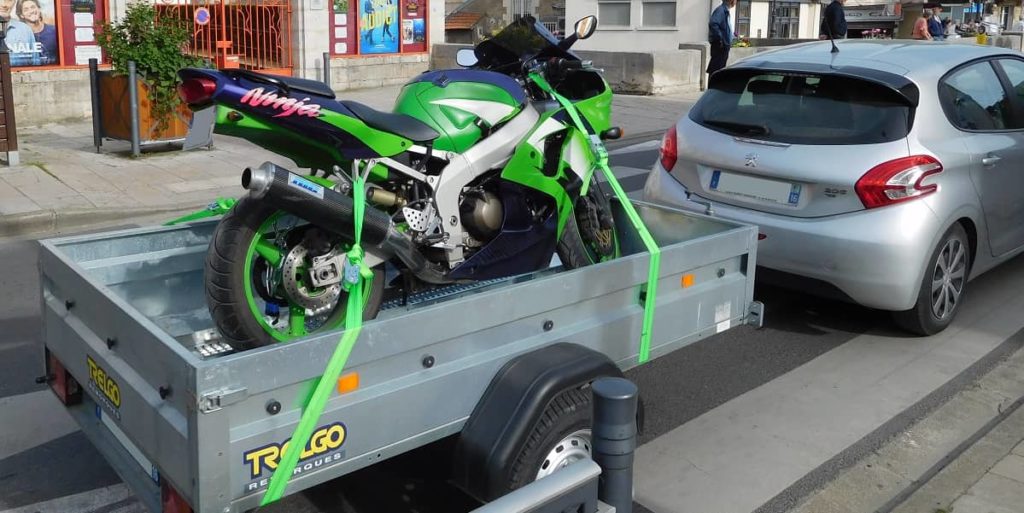To avoid damage to your bike when transporting it on an open trailer, it’s important to tie it down properly. The last thing you want is for your bike to slide around in the back, getting scratched up and becoming a safety hazard.
Is A Wheel Chock Your Best Bet?

The most common way to tie down a motorcycle is using a wheel chock. These are steel wedges designed to hold the wheel of your bike and support its weight, so it doesn’t shift or fall over when the vehicle makes sharp turns or goes over bumps.
But considering its size, a chock may not be suitable for trailers with limited space. A low-cost trailer does not typically come with it, so you may have to buy them separately. Also, not all types of bike wheels can always fit a wheel chock.
In most situations, you should be using wheel chocks.
But there are alternative ways to tie down a motorcycle without a chock where you don’t have that option.
Alternatives to a Wheel Chock
The main reason why people use a wheel chock is that it holds their tires firmly in place. So when you’re choosing an alternative, it needs to be just as sturdy to stop the wheels from turning. A piece of plastic, metal, wood or even a pair of bricks can all be good options.
If the floor of your trailer is wooden, you can also cut a sheet of 3/4 inch OSB to the width of the trailer, put some holes in them for the tie-down, and bolt pieces of 2X4s with deck screws.
Depending on the size and weight of your bike, you will have to improvise with these materials to ensure they are an ideal fit for the tire. You can even throw in a towel or two to act as an added support wedge. Once the wheel is thoroughly secured, it’s time to tie the bike down.
The Do’s and Don’ts of Tying Down A Motorcycle

If you’re not careful, the simple act of tying down a motorcycle to a trailer can be a real hassle.
It’s important to do it right to avoid accidents and unwarranted damages. So, here are some dos and don’ts of tying a bike on a trailer without a wheel chock:
Read: How to tow a motorcycle
The Dos:
- It is crucial that you use a good quality ratchet strap because it will help you fasten the bike properly and keep it stable from all sides. Cheap straps can break off quickly, causing your bike to wobble around.
- Wrap the ratchet straps with soft loops to prevent the hooks of the ratchet from leaving scratches on your bike. If you have fixtures on the floor of the trailer, you can use them to tie the soft loops as well.
- Strap the bike down on two points at the front and rear wheels. In the front, you can use the front forks of the bike for the tie-down.
- As an added protection for your bike, consider covering it with blankets to prevent scratches and potential damage from the material you use.
- Although the odds are very slim, you can keep the bike in gear in order to minimize the damage that may occur if there is a strap failure or if it disengages from your self-made chock.
The Don’ts:
- Don’t compress the suspension of the front wheel too much. Only do it partially for the front and a little less for the rear This will prevent the bike from bouncing and loosening the straps when driving on a bumpy road.
- Avoid strapping the handlebars, as doing so can compress the bushings or bend the washers, causing the bars to loosen.
- Don’t throw the straps over your motorcycle’s seat or your saddlebags, as you will wear them down and leave marks.
- If you have spare material or slack from the strap, don’t leave it flapping around. Instead, tie it down securely to your trailer.
- Don’t forget to stop and do a load check every 25 to 30 miles to ensure everything is in place, especially If you have a long journey ahead.
Conclusion
The safest way to transport your motorcycle on a trailer is by using a motorcycle chock. But if you don’t have a proper one, you need to ensure that you’re using a suitable alternative and investing in high-quality ratchet straps to cinch the bike tightly to the frame so that it doesn’t move at all during transportation.
Also, read our guide to the best motorcycle loading ramp.
Image credit: Cjp24, CC BY-SA 4.0, via Wikimedia Commons